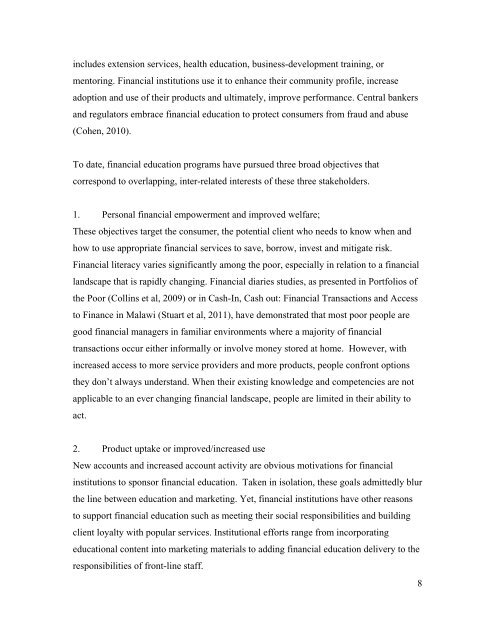Financial Literacy: A Step for Clients towards Financial Inclusion
Financial Literacy: A Step for Clients towards Financial Inclusion
Financial Literacy: A Step for Clients towards Financial Inclusion
You also want an ePaper? Increase the reach of your titles
YUMPU automatically turns print PDFs into web optimized ePapers that Google loves.
includes extension services, health education, business-development training, or<br />
mentoring. <strong>Financial</strong> institutions use it to enhance their community profile, increase<br />
adoption and use of their products and ultimately, improve per<strong>for</strong>mance. Central bankers<br />
and regulators embrace financial education to protect consumers from fraud and abuse<br />
(Cohen, 2010).<br />
To date, financial education programs have pursued three broad objectives that<br />
correspond to overlapping, inter-related interests of these three stakeholders.<br />
1. Personal financial empowerment and improved welfare;<br />
These objectives target the consumer, the potential client who needs to know when and<br />
how to use appropriate financial services to save, borrow, invest and mitigate risk.<br />
<strong>Financial</strong> literacy varies significantly among the poor, especially in relation to a financial<br />
landscape that is rapidly changing. <strong>Financial</strong> diaries studies, as presented in Portfolios of<br />
the Poor (Collins et al, 2009) or in Cash-In, Cash out: <strong>Financial</strong> Transactions and Access<br />
to Finance in Malawi (Stuart et al, 2011), have demonstrated that most poor people are<br />
good financial managers in familiar environments where a majority of financial<br />
transactions occur either in<strong>for</strong>mally or involve money stored at home. However, with<br />
increased access to more service providers and more products, people confront options<br />
they don’t always understand. When their existing knowledge and competencies are not<br />
applicable to an ever changing financial landscape, people are limited in their ability to<br />
act.<br />
2. Product uptake or improved/increased use<br />
New accounts and increased account activity are obvious motivations <strong>for</strong> financial<br />
institutions to sponsor financial education. Taken in isolation, these goals admittedly blur<br />
the line between education and marketing. Yet, financial institutions have other reasons<br />
to support financial education such as meeting their social responsibilities and building<br />
client loyalty with popular services. Institutional ef<strong>for</strong>ts range from incorporating<br />
educational content into marketing materials to adding financial education delivery to the<br />
responsibilities of front-line staff.<br />
8












